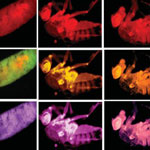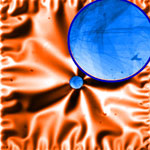Showing Spotlights 1569 - 1576 of 2780 in category All (newest first):
 Fruit flies (Drosophila melanogaster) are the workhorses in countless biomedical research laboratories around the world. The bioimaging of live specimens, ideally through all the stages of the fruit fly life cycle, is a tricky and often complicated undertaking. Researchers in India have now developed a relatively simple way to introduce fluorescent nanomaterials into fruit flies: They prepared carbon nanoparticles from wood waste and added them to the flies' food supply. The fluorescent fruit flies showed no toxic effects - upon withdrawal of the nanoparticles from their food, they excreted the fluorescing material and continued to proliferate to the next generation, demonstrating a return to their normal lives.
Fruit flies (Drosophila melanogaster) are the workhorses in countless biomedical research laboratories around the world. The bioimaging of live specimens, ideally through all the stages of the fruit fly life cycle, is a tricky and often complicated undertaking. Researchers in India have now developed a relatively simple way to introduce fluorescent nanomaterials into fruit flies: They prepared carbon nanoparticles from wood waste and added them to the flies' food supply. The fluorescent fruit flies showed no toxic effects - upon withdrawal of the nanoparticles from their food, they excreted the fluorescing material and continued to proliferate to the next generation, demonstrating a return to their normal lives.
Nov 8th, 2011
 Colloidal silver is not a health elixir and should not be taken orally. Still, dubious online resources that sell silver dispersions or explain how to synthesize colloidal silver for nutritional purposes keep propagating mystic health effects of nano-silver. Whoever considers to "treat" themselves by taking colloidal silver certainly don't know what they want to treat themselves for. They should be aware that drinking an antimicrobial agent at any effectual dosage must inevitably cause harm to innumerable bacteria that are vital to our organism - especially in the alimentary canal. Drinking colloidal silver will either be noneffective or harmful. It is not medicine.
Colloidal silver is not a health elixir and should not be taken orally. Still, dubious online resources that sell silver dispersions or explain how to synthesize colloidal silver for nutritional purposes keep propagating mystic health effects of nano-silver. Whoever considers to "treat" themselves by taking colloidal silver certainly don't know what they want to treat themselves for. They should be aware that drinking an antimicrobial agent at any effectual dosage must inevitably cause harm to innumerable bacteria that are vital to our organism - especially in the alimentary canal. Drinking colloidal silver will either be noneffective or harmful. It is not medicine.
Nov 4th, 2011
 Lithium-ion batteries have been widely used in many electronic devices that are important to our daily life. However, after a steady improvement of some 10-15% during the last two decades, the energy density of lithium-ion batteries is now approaching its theoretical limit set by the energies of cathode and anode materials used in these batteries. Therefore, in recent years, the pursuit of the next generation of energy storage systems has been intense globally. Among various electrochemical energy storage systems explored to date, the lithium-air (Li-air) battery is one of the most promising technologies, with a theoretical energy density nearly ten times that of conventional lithium-ion batteries. A novel air electrode consisting of an unusual hierarchical arrangement of functionalized graphene sheets delivers an exceptionally high capacity.
Lithium-ion batteries have been widely used in many electronic devices that are important to our daily life. However, after a steady improvement of some 10-15% during the last two decades, the energy density of lithium-ion batteries is now approaching its theoretical limit set by the energies of cathode and anode materials used in these batteries. Therefore, in recent years, the pursuit of the next generation of energy storage systems has been intense globally. Among various electrochemical energy storage systems explored to date, the lithium-air (Li-air) battery is one of the most promising technologies, with a theoretical energy density nearly ten times that of conventional lithium-ion batteries. A novel air electrode consisting of an unusual hierarchical arrangement of functionalized graphene sheets delivers an exceptionally high capacity.
Nov 2nd, 2011
 Using the CVD process, manufacturers can combine a metal catalyst such as iron with reaction gases such as hydrocarbon to form carbon nanotubes inside a high-temperature furnace. This process creates CNTs that are subsequently deposited in a collection environment and harvested into the desired end-product structural form. Understanding the processes in CVD growth of carbon nanotubes is important for their high yield and extended production. But even today, some 20 years since their discovery, the finer details of CNT growth mechanisms remain poorly understood. One of the issues that manufacturers have to grapple with is the levelling off and ultimate stoppage of CNT growth several minutes into the CVD process. This is referred to as catalyst poisoning - an inactivation or poisoning process of catalyst particles that has been attributed to an overcoat of amorphous carbon.
Using the CVD process, manufacturers can combine a metal catalyst such as iron with reaction gases such as hydrocarbon to form carbon nanotubes inside a high-temperature furnace. This process creates CNTs that are subsequently deposited in a collection environment and harvested into the desired end-product structural form. Understanding the processes in CVD growth of carbon nanotubes is important for their high yield and extended production. But even today, some 20 years since their discovery, the finer details of CNT growth mechanisms remain poorly understood. One of the issues that manufacturers have to grapple with is the levelling off and ultimate stoppage of CNT growth several minutes into the CVD process. This is referred to as catalyst poisoning - an inactivation or poisoning process of catalyst particles that has been attributed to an overcoat of amorphous carbon.
Oct 31st, 2011
 Lipids are the main component of the outermost membrane of cells. Their role is to seperate the inner and outer media of the cell and prevent any ionic current between these two media. Because of this last property, lipid layers can be thought of as good ultra-thin insulators that could be used in the development of electronic devices. So far though, because of their inherent instability in air, their use in advanced processes has been limited. This might change, though, since researchers in France have shown the possibility to stabilize by polymerization a lipid monolayer with a thickness of 2.7 nm directly at the surface of H-terminated silicon surface therefore opening a whole new world of possibilities of the use of these layers. Now, they reported the electrical performance of stabilized lipid monolayers on H-terminated silicon.
Lipids are the main component of the outermost membrane of cells. Their role is to seperate the inner and outer media of the cell and prevent any ionic current between these two media. Because of this last property, lipid layers can be thought of as good ultra-thin insulators that could be used in the development of electronic devices. So far though, because of their inherent instability in air, their use in advanced processes has been limited. This might change, though, since researchers in France have shown the possibility to stabilize by polymerization a lipid monolayer with a thickness of 2.7 nm directly at the surface of H-terminated silicon surface therefore opening a whole new world of possibilities of the use of these layers. Now, they reported the electrical performance of stabilized lipid monolayers on H-terminated silicon.
Oct 27th, 2011
 Analyzing the physicochemical processes that take place at surfaces and interfaces is an important aspect in materials science, catalysis, biochemistry and other fields. For many years, surface scientists have relied on powerful tools like X-ray Photoelectron Spectroscopy (XPS) and other spectroscopy techniques based on the detection of electrons. XPS reveals the elemental composition and chemical and electronic states of surfaces by irradiating a material with a beam of X-rays and measuring the energy and electrons that escape. However, it still remains a great experimental challenge to adapt powerful, surface sensitive tools such as XPS or to explore objects at ambient conditions. Researchers now demonstrate that graphene oxide membranes are a very promising window material for environmental cells to enable XPS studies of samples immersed in liquid or dense gaseous media.
Analyzing the physicochemical processes that take place at surfaces and interfaces is an important aspect in materials science, catalysis, biochemistry and other fields. For many years, surface scientists have relied on powerful tools like X-ray Photoelectron Spectroscopy (XPS) and other spectroscopy techniques based on the detection of electrons. XPS reveals the elemental composition and chemical and electronic states of surfaces by irradiating a material with a beam of X-rays and measuring the energy and electrons that escape. However, it still remains a great experimental challenge to adapt powerful, surface sensitive tools such as XPS or to explore objects at ambient conditions. Researchers now demonstrate that graphene oxide membranes are a very promising window material for environmental cells to enable XPS studies of samples immersed in liquid or dense gaseous media.
Oct 25th, 2011
 Breath analysis has been recognized as an increasingly accurate diagnostic method to link specific gaseous components in human breath to medical conditions and exposure to chemical compounds. Sampling breath is also much less invasive than testing blood, can be done very quickly, and creates as good as no biohazard waste. A recent review article in Environmental Science and Technology focuses on breath analysis as a tool for assessing environmental exposure and provides a good overview of the current state of diagnostic tools, leading studies in this field, and emerging technologies for hand-held breath analyzers. After describing the basics of breath analysis as a diagnostic tool, the authors discuss emerging chemical sensor technology ('electronic noses'), in particular two nanotechnology-based approaches, that are suitable to identify target analytes in breath.
Breath analysis has been recognized as an increasingly accurate diagnostic method to link specific gaseous components in human breath to medical conditions and exposure to chemical compounds. Sampling breath is also much less invasive than testing blood, can be done very quickly, and creates as good as no biohazard waste. A recent review article in Environmental Science and Technology focuses on breath analysis as a tool for assessing environmental exposure and provides a good overview of the current state of diagnostic tools, leading studies in this field, and emerging technologies for hand-held breath analyzers. After describing the basics of breath analysis as a diagnostic tool, the authors discuss emerging chemical sensor technology ('electronic noses'), in particular two nanotechnology-based approaches, that are suitable to identify target analytes in breath.
Oct 24th, 2011
 More than 100 companies around the world today are manufacturing carbon nanotubes and this number is expected to increase to more than 200 within the next five years, while there are more than 1,000 companies and institutions that are actively engaged in CNT research and development. This article looks at the market size, applications, processing technology and end-user products of carbon nanotubes. In addition, the study looks at industry leaders in the value chain, potential applications, products which are under development and are likely to enter the market in the next five to ten years. For this study, we have surveyed industry professionals/stakeholders in the CNTs value chain, extracted information from our proprietary in-house databases/ inter-linked databases as well as researched other primary and secondary sources and triangulated data and the findings are presented in this article.
More than 100 companies around the world today are manufacturing carbon nanotubes and this number is expected to increase to more than 200 within the next five years, while there are more than 1,000 companies and institutions that are actively engaged in CNT research and development. This article looks at the market size, applications, processing technology and end-user products of carbon nanotubes. In addition, the study looks at industry leaders in the value chain, potential applications, products which are under development and are likely to enter the market in the next five to ten years. For this study, we have surveyed industry professionals/stakeholders in the CNTs value chain, extracted information from our proprietary in-house databases/ inter-linked databases as well as researched other primary and secondary sources and triangulated data and the findings are presented in this article.
Oct 20th, 2011
 Fruit flies (Drosophila melanogaster) are the workhorses in countless biomedical research laboratories around the world. The bioimaging of live specimens, ideally through all the stages of the fruit fly life cycle, is a tricky and often complicated undertaking. Researchers in India have now developed a relatively simple way to introduce fluorescent nanomaterials into fruit flies: They prepared carbon nanoparticles from wood waste and added them to the flies' food supply. The fluorescent fruit flies showed no toxic effects - upon withdrawal of the nanoparticles from their food, they excreted the fluorescing material and continued to proliferate to the next generation, demonstrating a return to their normal lives.
Fruit flies (Drosophila melanogaster) are the workhorses in countless biomedical research laboratories around the world. The bioimaging of live specimens, ideally through all the stages of the fruit fly life cycle, is a tricky and often complicated undertaking. Researchers in India have now developed a relatively simple way to introduce fluorescent nanomaterials into fruit flies: They prepared carbon nanoparticles from wood waste and added them to the flies' food supply. The fluorescent fruit flies showed no toxic effects - upon withdrawal of the nanoparticles from their food, they excreted the fluorescing material and continued to proliferate to the next generation, demonstrating a return to their normal lives.
 Subscribe to our Nanotechnology Spotlight feed
Subscribe to our Nanotechnology Spotlight feed





